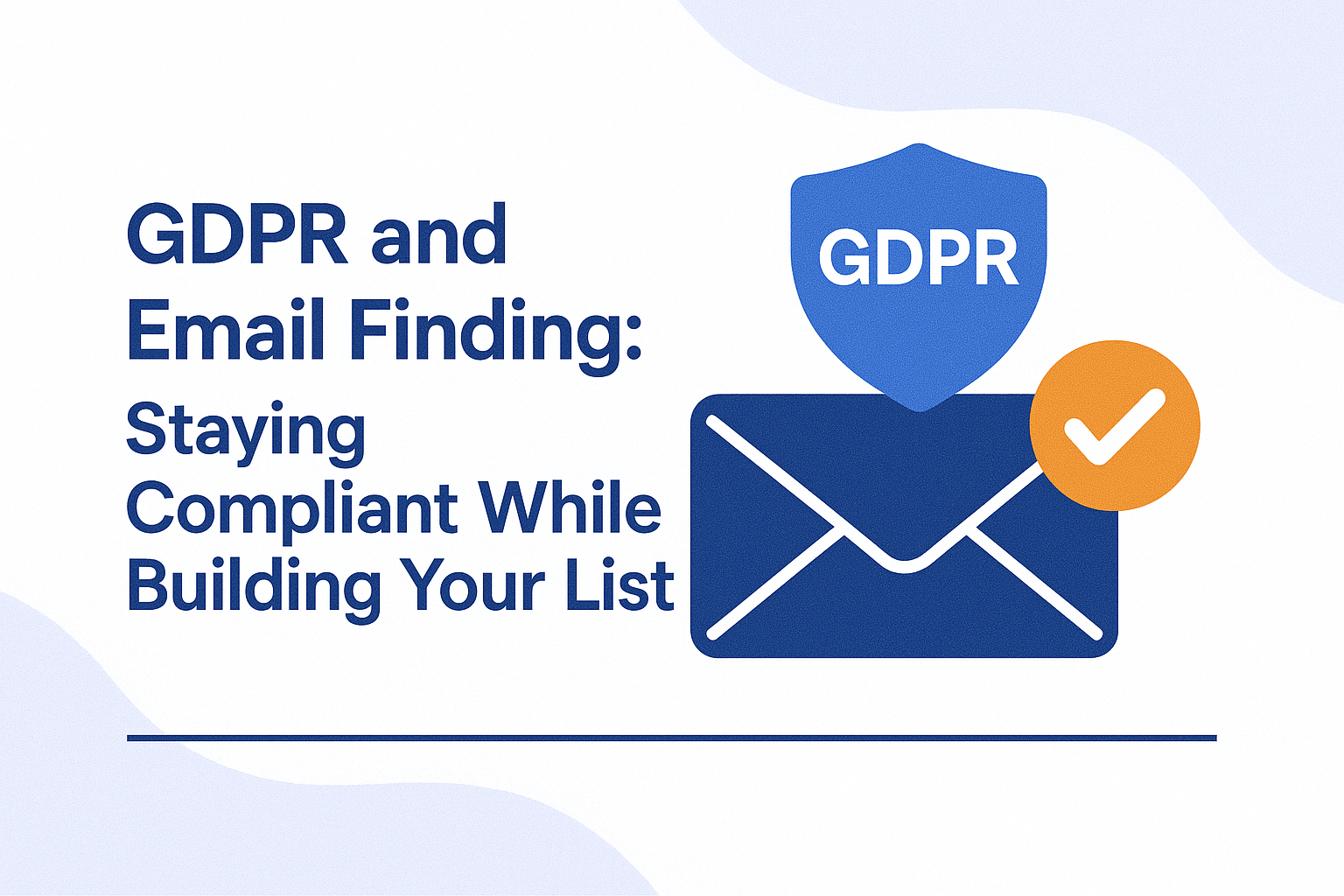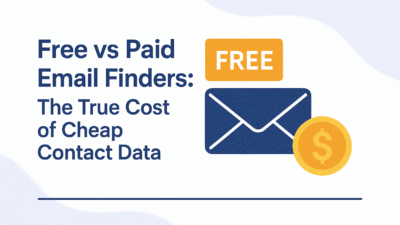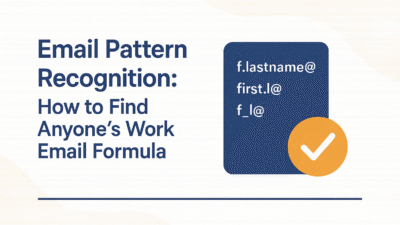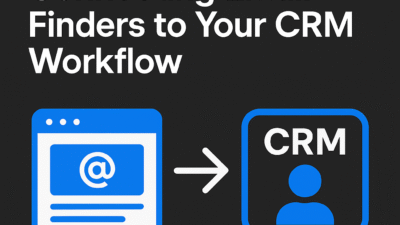Building email lists in today’s privacy-focused world requires balancing growth ambitions with strict legal compliance. The General Data Protection Regulation (GDPR) has fundamentally changed how businesses can collect, store, and use email addresses, creating both challenges and opportunities for companies serious about sustainable list building.
Many businesses struggle with GDPR compliance because they misunderstand what the regulation actually requires. Some abandon email list building entirely, fearing legal consequences. Others ignore GDPR requirements, risking massive fines and reputation damage. The smart approach lies between these extremes: understanding exactly what GDPR requires and building compliant processes that actually improve email marketing effectiveness.
GDPR compliance isn’t just about avoiding fines – it’s about building higher-quality email lists with engaged subscribers who genuinely want to hear from you. Compliant email finding practices result in better open rates, lower unsubscribe rates, and stronger customer relationships that drive long-term business value.
This guide covers everything you need to know about finding and collecting email addresses while staying fully compliant with GDPR. We’ll explore legal foundations, practical implementation strategies, and proven techniques that help you build valuable email lists without legal risks.
Whether you’re starting fresh with email marketing or updating existing practices for compliance, these strategies will help you navigate GDPR requirements while building lists that deliver real business results.
Understanding GDPR Requirements for Email Collection
GDPR establishes clear rules about how businesses can collect and use personal data, including email addresses. Understanding these requirements is essential for building compliant email finding strategies.
Legal Basis for Email Processing
GDPR requires a valid legal basis for processing personal data, including email addresses. The most common legal bases for email marketing are consent and legitimate interest, each with specific requirements and implications.
Consent must be freely given, specific, informed, and unambiguous. This means subscribers must actively choose to provide their email address for specific purposes. Pre-checked boxes, implied consent, or bundled agreements don’t meet GDPR consent standards.
Legitimate interest allows email processing when you have genuine business reasons that don’t override individual privacy rights. This basis requires careful assessment and documentation but can be appropriate for certain business communications.
The legal basis you choose affects how you can collect emails, what you must tell subscribers, and how you handle opt-outs. Most email marketing relies on consent because it provides clearer guidelines and stronger subscriber relationships.
Data Subject Rights and Email Lists
GDPR grants individuals specific rights regarding their personal data that directly impact email list management. Understanding these rights helps you build compliant processes from the start.
Right to be informed requires clear communication about how you collect and use email addresses. This includes updating privacy policies and providing transparency during email collection.
Right of access means individuals can request information about what data you hold and how you use it. This includes email addresses, subscription preferences, and any associated profile information.
Right to rectification allows people to correct inaccurate information, including email addresses and profile data. This right supports list quality while ensuring compliance.
Right to erasure (right to be forgotten) requires deletion of personal data in certain circumstances. This goes beyond simple unsubscribes to complete data removal when requested.
Right to data portability allows individuals to obtain and transfer their personal data. For email lists, this might include subscription preferences and interaction history.
Consent Requirements and Documentation
Valid GDPR consent requires specific characteristics that affect how you design email collection processes. Understanding these requirements helps create compliant and effective lead generation strategies.
Consent must be freely given, meaning no coercion, bundling with other services, or negative consequences for refusing. This eliminates many traditional lead generation tactics that pressure people into subscribing.
Specific consent requires clear explanation of what people are agreeing to receive. Generic “marketing communications” isn’t sufficient – you must specify email types, frequency, and content topics.
Informed consent means providing enough information for people to make meaningful decisions. This includes explaining data use, sharing practices, and retention periods.
Unambiguous consent requires clear affirmative action. Pre-checked boxes, inactivity, or silence don’t constitute valid consent under GDPR.
Consent documentation requires maintaining records that prove when and how consent was obtained. This includes timestamps, IP addresses, consent text, and any subsequent changes to consent status.
Geographic Scope and Application
GDPR applies to any organization processing personal data of EU residents, regardless of where the organization is located. This broad scope affects most international businesses and many domestic companies.
Territorial scope extends beyond EU-based companies to include any organization offering goods or services to EU residents or monitoring EU resident behavior. This includes websites accessible from the EU, even if not specifically targeting EU markets.
Data processing activities covered by GDPR include collection, storage, organization, retrieval, consultation, use, disclosure, and deletion of personal data. Email finding and list building clearly fall within these activities.
Representative requirements may apply to non-EU organizations subject to GDPR, potentially requiring designation of EU representatives for data protection matters.
Understanding geographic scope helps determine GDPR applicability and necessary compliance measures for your specific situation and target markets.
Compliant Email Finding Strategies
Building email lists under GDPR requires thoughtful strategies that prioritize transparency, value, and genuine subscriber interest rather than aggressive acquisition tactics.
Opt-in Forms and Landing Pages
Effective opt-in forms balance compliance requirements with conversion optimization. The key is making subscription benefits clear while meeting all GDPR consent requirements.
Clear value propositions help people understand why they should subscribe and what they’ll receive. Specific benefits like “weekly industry insights” or “exclusive product updates” work better than generic “newsletter” descriptions.
Granular consent options allow subscribers to choose specific email types or topics rather than all-or-nothing subscriptions. This improves compliance while enabling better targeting and personalization.
Transparency in signup forms includes clear explanations of email frequency, content types, and data usage. This information should be easily accessible without overwhelming the signup process.
Double opt-in processes provide additional consent verification and improve list quality. While not always required under GDPR, double opt-in demonstrates clear consent and reduces compliance risks.
Form design considerations ensure consent checkboxes are unchecked by default, consent language is clear and specific, and privacy information is easily accessible during signup.
Content Marketing and Lead Magnets
Content marketing provides valuable resources in exchange for email addresses, creating natural subscription opportunities that align with GDPR’s emphasis on value and consent.
High-value content like comprehensive guides, exclusive research, or useful tools provides clear value that justifies email address collection. The content quality should match the subscription commitment you’re requesting.
Gated content strategies must balance access control with consent requirements. Clear explanations of why email addresses are required and how they’ll be used help maintain compliance while protecting valuable content.
Progressive profiling allows gradual information collection rather than overwhelming initial forms. This approach respects user privacy while building detailed subscriber profiles over time.
Content relevance ensures lead magnets attract genuinely interested subscribers rather than people only interested in free content. Relevant content leads to better engagement and lower unsubscribe rates.
Download delivery methods should reinforce subscription benefits and set appropriate expectations for future communications. This helps maintain positive subscriber relationships from the first interaction.
Social Media and Organic Growth
Social media platforms provide compliant opportunities for email list growth through authentic engagement and valuable content sharing.
Platform-specific strategies respect each social network’s unique characteristics while driving traffic to compliant email signup processes. This might include LinkedIn thought leadership, Instagram stories with signup links, or Twitter conversations that highlight email content value.
Cross-promotion techniques leverage existing social followers to grow email lists through valuable content previews, exclusive subscriber benefits, or community building around shared interests.
Engagement-based targeting focuses on people who already interact with your content rather than broad audience targeting. Engaged social media followers are more likely to become engaged email subscribers.
Compliance in social advertising ensures any paid promotion of email signups meets both platform policies and GDPR requirements. This includes clear consent language and transparent data usage explanations.
Community building creates natural environments where people want to stay connected through email updates. Strong communities generate organic subscription growth with highly engaged members.
Partnership and Co-marketing
Strategic partnerships can expand email reach while maintaining compliance, but require careful attention to consent and data sharing requirements.
Joint content creation with complementary businesses provides value to both audiences while expanding reach. Partnerships should clearly communicate how subscriber data will be used and shared.
Cross-promotion agreements must respect existing subscriber consent and preferences. You cannot simply share email lists between partners without proper consent for such sharing.
Event-based collection through webinars, conferences, or workshops provides natural subscription opportunities. Event-related emails often have clear value propositions that support strong consent.
Referral programs can encourage existing subscribers to recommend your content to others, but must avoid incentivizing unwanted subscriptions or consent manipulation.
Co-branded lead magnets leverage partner expertise and audiences while maintaining clear consent for both organizations’ communications. Subscribers should understand what they’re agreeing to receive from each partner.
Technical Implementation for GDPR Compliance
Compliant email finding requires robust technical systems that support consent management, data protection, and subscriber rights throughout the entire customer lifecycle.
Consent Management Systems
Effective consent management goes beyond simple checkbox tracking to comprehensive documentation and ongoing consent monitoring.
Consent capture mechanisms must record not just subscription status but the specific consent given, including exact form language, timestamp, IP address, and consent scope. This documentation proves compliance during audits or investigations.
Consent versioning tracks changes to privacy policies, email types, or consent language over time. When consent requirements change, systems must identify subscribers who need to provide updated consent.
Granular consent tracking manages different consent types for various email categories, frequencies, or purposes. Subscribers might consent to product updates but not promotional emails, requiring sophisticated preference management.
Consent renewal processes handle situations where consent expires or requires refresh. Some organizations implement periodic consent confirmation to ensure ongoing engagement and compliance.
Audit trails maintain complete histories of consent-related actions, including initial consent, preference changes, withdrawals, and system modifications. These trails support compliance demonstration and troubleshooting.
Data Minimization and Retention
GDPR’s data minimization principle requires collecting only necessary information and retaining it only as long as needed for specified purposes.
Collection limitation means requesting only email addresses and information directly relevant to your email marketing purposes. Excessive data collection creates compliance risks without providing proportional benefits.
Purpose specification requires clear documentation of why you collect each data point and how it supports your email marketing objectives. This documentation guides both collection practices and retention decisions.
Retention scheduling establishes clear timelines for data deletion based on subscription status, engagement levels, and business requirements. Inactive subscribers shouldn’t remain on lists indefinitely.
Automated deletion processes remove subscriber data according to retention schedules without manual intervention. This reduces compliance burdens while ensuring consistent policy application.
Data quality maintenance includes regular cleanup of duplicate records, correction of inaccurate information, and removal of obviously invalid data. Quality maintenance supports both compliance and marketing effectiveness.
Privacy by Design Implementation
Privacy by design integrates data protection considerations into every aspect of email finding and list management systems.
Default privacy settings ensure systems protect subscriber privacy unless specifically configured otherwise. This includes default unsubscribe options, privacy-friendly data sharing settings, and minimal data collection.
Encryption and security protect subscriber data throughout collection, storage, and processing. This includes secure transmission protocols, encrypted databases, and access controls.
Access controls limit who can view and modify subscriber data based on legitimate business needs. Role-based permissions ensure appropriate data access without excessive exposure.
Data processing logging tracks all activities involving subscriber data, including access, modifications, exports, and deletions. These logs support audit requirements and incident investigation.
Incident response procedures outline steps for handling data breaches, unauthorized access, or other security incidents affecting subscriber information. Quick response minimizes harm and demonstrates compliance commitment.
API Integration and Data Flows
Email APIs must support GDPR compliance requirements while enabling effective marketing automation and personalization.
Consent propagation ensures subscription preferences and consent status flow correctly between systems. Marketing automation platforms must respect consent limitations established during collection.
Data synchronization maintains consistent subscriber information across platforms while respecting data minimization principles. Synchronization should not create unnecessary data copies or extended retention.
Third-party integrations require careful evaluation of partner compliance and data handling practices. Data processing agreements must address GDPR requirements for any external integrations.
Cross-border data transfers must comply with GDPR requirements when subscriber data moves between different countries or regions. This may require standard contractual clauses or adequacy decisions.
Real-time preference updates allow immediate implementation of subscriber preference changes across all connected systems. Delays in preference updates can create compliance violations and subscriber frustration.
Building Compliant Subscriber Relationships
GDPR compliance extends beyond initial collection to ongoing relationship management that respects subscriber preferences and rights throughout the customer lifecycle.
Transparent Communication Practices
Transparency builds trust while meeting GDPR requirements for clear communication about data processing activities.
Clear privacy policies explain email collection, usage, sharing, and retention practices in language subscribers can understand. Policies should be easily accessible and regularly updated.
Subscription confirmation communications set clear expectations about email frequency, content types, and unsubscribe processes. This initial communication establishes the foundation for compliant ongoing relationships.
Regular communication about privacy practices, data usage, or policy changes keeps subscribers informed about how their information is handled. Proactive communication demonstrates respect for subscriber privacy.
Preference center design makes it easy for subscribers to understand and modify their subscription preferences. Clear options and explanations help subscribers make informed decisions about their email preferences.
Unsubscribe processes must be simple, fast, and effective. Complex unsubscribe procedures violate GDPR requirements and damage subscriber relationships.
Preference Management and Segmentation
Sophisticated preference management respects subscriber choices while enabling effective email marketing targeting and personalization.
Granular preference options allow subscribers to choose specific email types, topics, frequencies, or formats rather than simple on/off subscriptions. This flexibility improves compliance while reducing unsubscribes.
Preference center functionality should be user-friendly and accessible, allowing easy modification of subscription preferences without requiring technical knowledge or multiple steps.
Segmentation based on consent ensures marketing campaigns only reach subscribers who have specifically consented to receive relevant content types. This respects subscriber choices while improving campaign relevance.
Preference inheritance handles how new email types or content categories apply to existing subscribers. Default options should err on the side of privacy protection rather than assumed consent.
Temporary preference changes accommodate subscribers who want to pause emails temporarily rather than unsubscribing permanently. This flexibility maintains relationships during busy periods or life changes.
Ongoing Consent Monitoring
Active consent monitoring ensures subscriber preferences remain current and subscription relationships stay healthy over time.
Engagement tracking identifies subscribers who may no longer be interested in receiving emails, even if they haven’t formally unsubscribed. Low engagement can indicate consent withdrawal or changing interests.
Preference drift detection monitors for changes in subscriber behavior that might indicate changing preferences or consent status. This helps identify subscribers who need preference updates or re-engagement.
Consent refresh campaigns periodically confirm subscriber interest and update preferences for long-term subscribers. These campaigns demonstrate ongoing commitment to consent while improving list quality.
Inactive subscriber management handles subscribers who stop engaging with emails over time. Clear policies help determine when to attempt re-engagement versus when to remove inactive subscribers.
Consent withdrawal processing ensures immediate and complete respect for unsubscribe requests and consent withdrawals. Fast processing demonstrates compliance commitment and respects subscriber decisions.
Data Subject Rights Management
GDPR grants individuals specific rights regarding their personal data that require systematic processes and quick response capabilities.
Right to Access Implementation
Subscribers have the right to know what personal data you hold and how you use it. Implementing this right requires comprehensive data mapping and efficient response processes.
Data inventory systems track all subscriber information across platforms, including email addresses, preference settings, engagement history, and any supplementary profile data.
Response procedures establish clear workflows for handling access requests, including identity verification, data compilation, and delivery methods. Response times must meet GDPR’s one-month requirement.
Information formatting presents subscriber data in understandable formats that clearly explain what information is held, how it’s used, and where it came from. Technical database dumps don’t meet accessibility requirements.
Verification processes confirm requester identity without creating excessive barriers to legitimate access requests. Balance security needs with accessibility requirements.
Documentation standards maintain records of access requests and responses for compliance demonstration and process improvement purposes.
Right to Rectification Support
Subscribers can request correction of inaccurate personal information, including email addresses, names, and preference settings.
Correction workflows enable quick updates to subscriber information while maintaining audit trails of changes made. This includes both subscriber-initiated corrections and proactive data quality improvements.
Verification requirements may be necessary for significant changes that could affect account security or subscription validity. Balance verification needs with user convenience.
System synchronization ensures corrections propagate across all connected platforms and databases to maintain data consistency and prevent outdated information from reappearing.
Proactive quality management identifies and corrects obvious data errors before subscribers request changes. This demonstrates data stewardship while reducing correction request volume.
Impact assessment evaluates how data corrections might affect personalization, segmentation, or campaign targeting to ensure marketing effectiveness continues after corrections.
Right to Erasure Processing
The right to be forgotten requires complete data deletion in certain circumstances, going beyond simple unsubscribe processing.
Deletion scope determination evaluates whether erasure requests meet GDPR criteria and what data must be deleted versus what can be retained for legitimate purposes.
Complete data removal eliminates all traces of subscriber information across platforms, backups, and archives while maintaining compliance documentation about the deletion itself.
Third-party notification informs data processors, partners, or service providers about erasure requirements when subscriber data has been shared for legitimate purposes.
System verification confirms successful data deletion across all platforms and prevents deleted data from reappearing through system synchronization or backup restoration.
Documentation requirements maintain records of erasure requests and actions taken while avoiding retention of the deleted personal data itself.
Data Portability Implementation
Subscribers have the right to obtain their personal data in portable formats and transfer it to other organizations when technically feasible.
Export functionality provides subscriber data in structured, commonly used formats like CSV or JSON that can be easily imported into other systems.
Data scope definition determines what information must be included in portability requests versus what falls outside portability requirements. This typically includes provided data and derived preferences but not analytics or marketing insights.
Transfer assistance may include direct data transfer to other organizations when technically feasible and specifically requested by the subscriber.
Format standardization ensures exported data uses consistent structures and formats that maximize portability and usability in other systems.
Security measures protect exported data during generation, storage, and transmission while ensuring only authorized individuals receive portable data.
International Considerations and Best Practices
GDPR compliance requires understanding international data flows, varying privacy requirements, and global best practices for email list building.
Cross-Border Data Transfers
Email marketing often involves data transfers between countries with different privacy requirements, requiring careful attention to transfer mechanisms and safeguards.
Adequacy decisions provide the simplest mechanism for data transfers to countries the EU considers to have adequate data protection. These decisions eliminate the need for additional safeguards.
Standard contractual clauses enable transfers to countries without adequacy decisions by requiring specific contractual protections for transferred data. These clauses must be implemented correctly to provide legal protection.
Binding corporate rules allow multinational organizations to transfer data between affiliates under approved corporate privacy policies. This mechanism requires advance approval but provides flexibility for complex organizations.
Transfer impact assessments evaluate risks associated with specific data transfers and determine appropriate safeguards. These assessments consider destination country laws, data sensitivity, and available protections.
Documentation requirements maintain records of all cross-border transfers, including legal mechanisms used, safeguards implemented, and risk assessments performed.
Multi-Jurisdictional Compliance
Organizations operating across multiple countries must navigate varying privacy requirements while maintaining operational efficiency.
Regulatory mapping identifies privacy requirements in each jurisdiction where you collect or process email addresses. This includes national laws, sector-specific regulations, and emerging privacy legislation.
Compliance prioritization focuses on the most restrictive requirements when multiple jurisdictions apply. Meeting the highest standard often ensures compliance across multiple regions.
Local representation may be required in certain jurisdictions, particularly when processing significant amounts of local resident data without maintaining local operations.
Cultural considerations adapt privacy practices to local expectations and cultural norms while maintaining legal compliance. Privacy expectations vary significantly across cultures and regions.
Regulatory monitoring tracks changes in privacy laws and enforcement practices across relevant jurisdictions to ensure ongoing compliance as requirements evolve.
Industry-Specific Requirements
Certain industries face additional privacy requirements beyond general GDPR compliance, affecting email collection and processing practices.
Healthcare privacy requirements like HIPAA in the US or medical privacy laws in other countries may restrict email collection and usage for health-related organizations.
Financial services regulations often include specific privacy and communication requirements that affect email marketing practices for banks, insurance companies, and financial advisors.
Education privacy laws protect student information and may limit how educational institutions can collect and use email addresses for marketing purposes.
Children’s privacy requires special protections for individuals under 16 (or 13 in some jurisdictions), including parental consent requirements and enhanced data protection measures.
Sector-specific guidance from regulatory authorities provides additional clarity about privacy requirements for specific industries or business models.
Measuring Compliance and Performance
Effective GDPR compliance requires ongoing measurement and optimization to ensure both legal adherence and marketing effectiveness.
Compliance Metrics and KPIs
Regular monitoring of compliance indicators helps identify issues before they become violations while demonstrating ongoing commitment to privacy protection.
Consent rates track the percentage of website visitors who subscribe to emails, helping evaluate the effectiveness of value propositions and consent processes.
Consent quality metrics measure the durability and engagement of subscribers acquired through compliant processes versus those from questionable sources.
Response time tracking monitors how quickly you respond to data subject requests to ensure compliance with regulatory timelines and demonstrate respect for subscriber rights.
Data accuracy rates measure the quality and correctness of subscriber information, supporting both compliance and marketing effectiveness.
Preference adherence tracks how well email campaigns respect subscriber preferences and consent limitations, preventing compliance violations and improving subscriber satisfaction.
Performance Impact Analysis
GDPR compliance should improve rather than hinder email marketing performance when implemented thoughtfully.
List quality improvements from compliant collection practices typically result in higher engagement rates, lower bounce rates, and better deliverability compared to non-compliant acquisition methods.
Subscriber lifetime value analysis compares compliant versus non-compliant acquisition channels to demonstrate the long-term value of privacy-respecting practices.
Engagement correlation examines relationships between consent clarity, preference granularity, and subscriber engagement to optimize both compliance and performance.
Conversion tracking measures how compliant email practices affect conversion rates and revenue attribution to demonstrate business value of privacy investment.
Cost-benefit analysis evaluates compliance investment against risk reduction, performance improvements, and competitive advantages to justify privacy program costs.
Continuous Improvement Processes
Privacy compliance requires ongoing attention and regular updates to maintain effectiveness as regulations, technology, and business needs evolve.
Regular compliance audits assess current practices against regulatory requirements and identify areas for improvement or risk reduction.
Process optimization refines consent collection, preference management, and data subject rights handling based on experience and feedback.
Technology updates ensure privacy systems remain current with regulatory changes, security best practices, and operational needs.
Training programs keep staff informed about privacy requirements, compliant practices, and incident response procedures.
Stakeholder feedback incorporates input from subscribers, privacy advocates, and regulatory guidance into ongoing compliance improvement efforts.
Future of Privacy and Email Marketing
Privacy regulations continue to evolve globally, requiring adaptive strategies that anticipate future requirements while maintaining effective email marketing capabilities.
Emerging Privacy Regulations
Privacy legislation is expanding rapidly beyond GDPR, creating a complex global landscape of requirements and expectations.
State-level privacy laws in the US, including California’s CCPA and Virginia’s CDPA, create patchwork requirements that may require national compliance strategies.
Asia-Pacific developments include new privacy laws in countries like India, Thailand, and updated requirements in established markets like Australia and Japan.
Sector-specific regulations continue emerging for industries like healthcare, finance, and technology, adding layers to general privacy requirements.
International coordination efforts aim to harmonize privacy requirements across borders while respecting national sovereignty and cultural differences.
Enforcement evolution shows increasing regulatory sophistication and cross-border cooperation, making compliance more important than ever.
Technology and Privacy Innovation
Advancing technology creates new opportunities for privacy-preserving email marketing while meeting evolving regulatory requirements.
Privacy-enhancing technologies like differential privacy, federated learning, and homomorphic encryption enable valuable analytics while protecting individual privacy.
Consent management platforms are becoming more sophisticated, offering granular control, automated compliance monitoring, and seamless user experiences.
Artificial intelligence applications in privacy include automated compliance monitoring, intelligent data minimization, and personalized privacy preference prediction.
Blockchain applications may enable decentralized consent management, transparent data usage tracking, and individual data ownership models.
Zero-party data strategies emphasize voluntary information sharing through value exchanges rather than surveillance-based data collection.
Building Future-Ready Systems
Sustainable email marketing requires systems designed to adapt to changing privacy requirements while maintaining operational effectiveness.
Flexible architecture enables quick adaptation to new privacy requirements without complete system overhauls or service disruptions.
Privacy-first design prioritizes data protection and user control in all system design decisions, making compliance easier and more natural.
Transparent operations build trust through clear communication about data practices and genuine respect for subscriber privacy preferences.
Stakeholder engagement includes privacy advocates, regulatory bodies, and subscribers in ongoing dialogue about privacy practices and improvements.
Continuous learning approaches treat privacy compliance as an ongoing capability rather than a fixed requirement, enabling adaptation to changing needs.
Conclusion
GDPR compliance in email finding and list building represents both a challenge and an opportunity for modern businesses. While the regulation requires significant changes to traditional email acquisition practices, it also creates advantages for organizations willing to invest in privacy-respecting, subscriber-focused approaches.
The businesses thriving under GDPR are those that view compliance not as a burden but as a competitive advantage. They’ve discovered that respecting subscriber privacy and preferences leads to higher-quality lists, better engagement rates, and stronger customer relationships that drive sustainable business growth.
Successful GDPR compliance requires understanding the regulation’s requirements, implementing robust technical systems, and maintaining ongoing attention to privacy practices. This investment pays dividends through reduced legal risks, improved email performance, and enhanced brand reputation among privacy-conscious consumers.
The key to sustainable compliance lies in building systems and processes that make privacy protection natural and automatic rather than burdensome and complex. When privacy considerations are integrated into every aspect of email marketing, compliance becomes a competitive advantage rather than a compliance burden.
As privacy regulations continue evolving globally, businesses with strong GDPR compliance foundations will be better positioned to adapt to new requirements and expand into international markets. The privacy practices developed for GDPR compliance provide templates for meeting similar requirements in other jurisdictions.
Your email marketing success in the post-GDPR world depends on embracing privacy as a core business value rather than treating it as a legal obligation. Subscribers increasingly value businesses that respect their privacy and provide transparent, valuable communications over those that prioritize aggressive acquisition and broad targeting.
The future belongs to businesses that can build large, engaged email lists while respecting subscriber privacy and preferences. GDPR provides the roadmap for achieving this balance, but success requires commitment to ongoing compliance improvement and genuine respect for subscriber rights.
The question isn’t whether to embrace GDPR compliance – it’s how quickly you can build privacy-respecting email marketing practices that turn regulatory requirements into competitive advantages and subscriber trust into business growth.
Related Articles
Ready to explore more about advanced email marketing strategies and compliance? Check out these comprehensive guides:
Why Your Email Marketing Needs an API: Beyond Basic Newsletter Platforms – Discover how APIs enable better privacy controls and compliance automation for modern email marketing.
Email Verification: Why 40% of Your Found Emails Might Be Useless – Learn how proper verification supports GDPR compliance while improving list quality and deliverability.
Email Deliverability Crisis: How APIs Save Your Sender Reputation – Understand how compliant email practices protect sender reputation and ensure consistent inbox placement.
Transactional vs Marketing Emails: Choosing the Right API for Each – Learn how different email types have different compliance requirements and implementation strategies.
Real-Time Email Analytics: What APIs Can Tell You That Platforms Can’t – Discover how advanced analytics support compliance monitoring and privacy-respecting personalization.
Scaling Email Marketing: When to Graduate from Mailchimp to APIs – Understand when basic platforms become limiting for compliance and how APIs provide better privacy controls.
The Hidden Costs of Email Marketing Platforms vs API Solutions – Analyze the true costs of compliance and how API solutions can reduce privacy-related risks and expenses.





